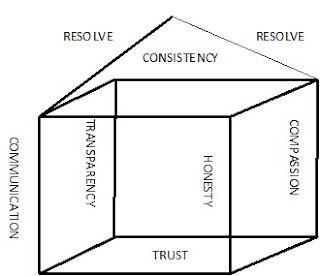Binocular Leadership – Protecting Your Employment Brand in Tough Times
 leader has to do all that with both the present and the future in mind. That kind of decision making requires a different kind of thinking, the kind that is much more holistic and dynamic and much wider. Balancing today’s decisions about today’s needs will oftentimes conflict with the right decision for tomorrow’s needs and that is why successful leaders use what could be called binocular vision. Decisions about displacement packages, building support infrastructure, etc… are much more complex than simply determining how much severance to provide.
leader has to do all that with both the present and the future in mind. That kind of decision making requires a different kind of thinking, the kind that is much more holistic and dynamic and much wider. Balancing today’s decisions about today’s needs will oftentimes conflict with the right decision for tomorrow’s needs and that is why successful leaders use what could be called binocular vision. Decisions about displacement packages, building support infrastructure, etc… are much more complex than simply determining how much severance to provide.Binocular vision allows the leader to alternate between what is and what will be without ever completely losing sight of either one. Using this kind of vision, decisions are filtered in both time spaces. Something else that leaders have to keep in front of mind when using binocular vision is that employees, especially those that are scared or distrustful, typically function with monocular vision. That means they are focusing on the here and now, so talking about the future can sometimes cause more discomfort than not talking at all. The paradox in that is the leader also has to know that both the employee’s monocular vision and how they (the leader) handle the employee will have a profound impact on the future of the organization.
This vision, while imperative during trying economic times, is however useless without the right leadership behaviors. These behaviors are not anything new, and in fact, are really pretty common sense, but unfortunately a rarity in many organizations. One thing to note is that these behaviors should be applied to both surviving employees as well as displaced employees. (That is a whole other aspect of binocular vision that we can cover in a separate discussion.) The best analogy to describe these behaviors is to compare good crisis leadership to a sturdy house.
Let’s look at this leadership house!
The FOUNDATION
- Trust – where it all begins. Every house starts with a foundation and our foundation, in this case, is trust. The leader should be able to accurately assess the level of general trust in the organization or within his or her team. If trust is not there, the best option is to draw a line, do a mea culpa and ask the employees to get on board and then leave it up to them. The leader has to recognize that trust is a precious commodity, not only for the surviving employees but also for those that are waiting on the sidelines hoping for a change in business!
The WALLS
- Honesty – has to be embedded in every action and every word above all else. The leader has to be honest, even if when it’s tough, to be honest. Employees have an enhanced sensitivity to what they are told during these times. The leader has to commit to a high level of integrity and recognize that one simple breach of trust can create immeasurable costs and prevent an organization from bouncing back when the economy returns.
- Communication – has to be constant and pervasive and two-way throughout the organization. If employees don’t have the information they want or feel they need or don’t get to say what they feel, they’ll start making assumptions. When they do, before you know it they are at the top of the Ladder of Inference and are ready to bail or worse yet, create more discontent within the organization. A key to remember regarding communication is that it has to occur with both current employees (surviving) and employees that have been displaced. That is where most organizations drop the ball when it comes to managing the present and the future. Leaders often-times get so caught up with the process and people challenges they are dealing with internally, they forget about those that left in the last round of layoffs. It is those people that the leader will need as soon as things turn up again and if they are forgotten, they too will forget. Communication has to be inside and outside of the organization and there are no short cuts and unfortunately very little room for forgiveness.
- Transparency – goes hand in hand with honesty. The more that is shared, the more trust is engendered. Scary times are scary times, but for employees not knowing makes it even scarier. Sometimes knowing the bad news is better than not knowing any news at all. The more that a leader can share with employees as things occur or as they are about to occur, the more confident employees will be, maybe not in their jobs, but in their leader who they believe will fight for their jobs.
- Compassion – is the last wall, but not because it is the least wall. In reality, compassion is the stuff we plaster all over the other walls but for the sake of this analogy, we’ll call it the fourth wall. Everything that the leader does during these times should be done from a position of true compassion. That does not mean that you make a decision based on compassion, but it does mean that you make and execute all decisions with compassion. To hold on to the employment brand, employees have to feel (and believe) that someone cares and is doing their best to watch out for them, even if it means cutting back hours or temporarily eliminating jobs. No promises, but instead assurances that they will not be left alone.
The ROOF
- Consistency – is the structure that sits on top of the walls and keeps them all together. Each of the four behaviors has to be consistent behaviors during these times. A slight deviation without explanation can cause extreme upset and turmoil and end up costing the leader more time putting out unnecessary fires when time is short already. Honesty, communication, transparency and compassion without consistency are simply empty words to a scared employee or scared displaced employee.
- Resolve – is the tar that covers the roof and protects the inside of the house from outside elements seeping in. A leader has to have resolve during these times. A leader that embraces the business and the employees, surviving and displaced, has to have resolve to survive and make it all work. Without that resolve, it is far too easy to allow ourselves to walk out on those that are counting on us most.
While leadership is never easy, leading during times like these make the good times seem like a cakewalk. Interestingly enough, these same behaviors that we ordinarily associate with good leadership are the same ones that best protect the employment brand of an organization during trying times. So what lesson does that provide us?


